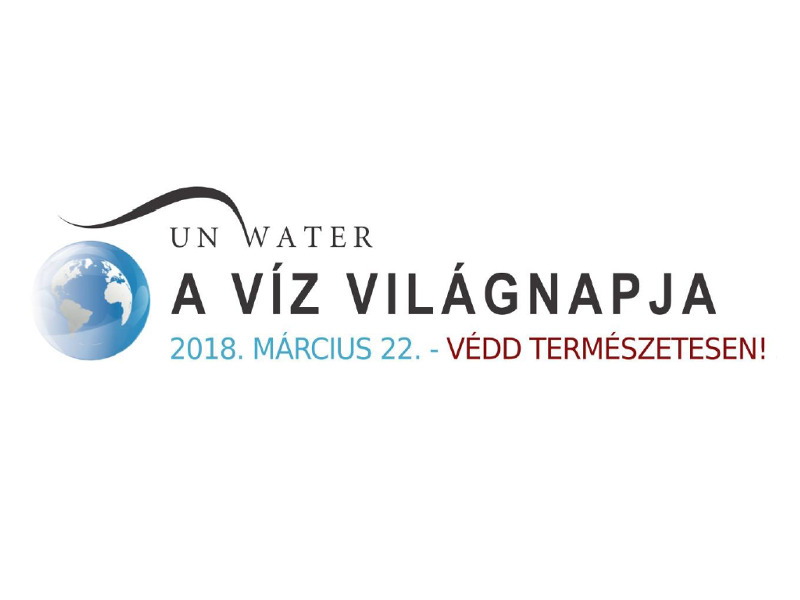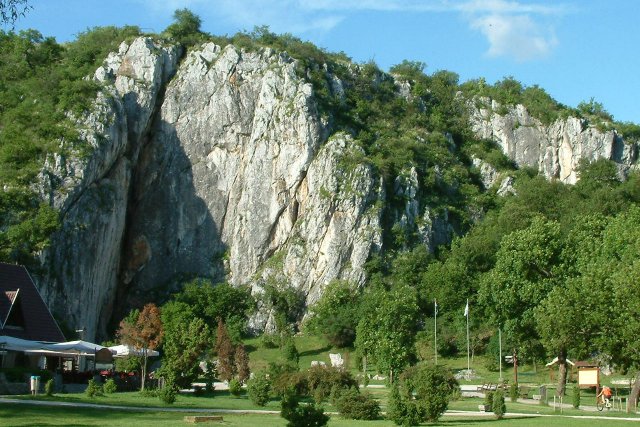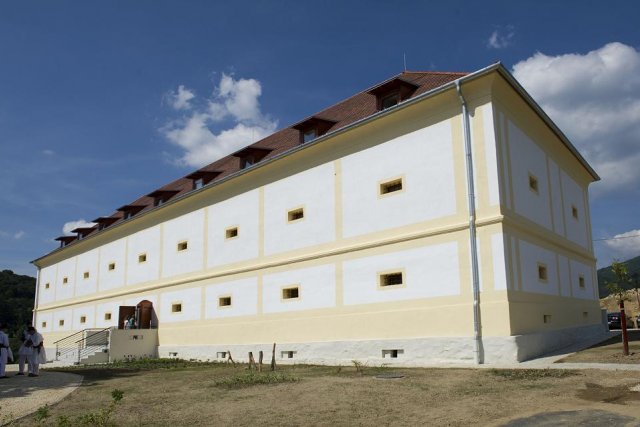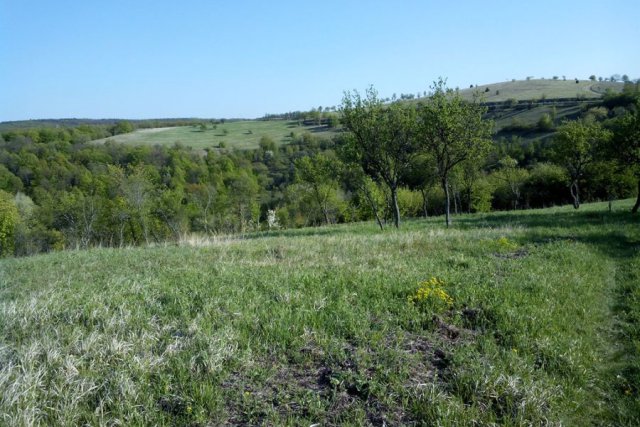
“Protect Naturally!”
The 21st century has seen the availability of clean water move from regional to a global problem. Less than 2% of the Earth’s water supply is fresh water. Of all the earth's water, 97% is salt water found in oceans and seas. Only 1% of the earth's water is available for drinking water. Two percent is frozen, and much of what is available is polluted or carries water-borne diseases. Many experts predict that access to clean drinking water may be one of the main sources of conflict in coming years. According to UNICEF, about 884 million people lack adequate access to safe drinking water.
A solution is offered by nature itself. In addition to the gray infrastructure such as canals and conduits that typically perform a single function, a green infrastructure is important because it also provides opportunities for simultaneous handling of multiple problems. The benefits of a green infrastructure include improved air and water quality, and the growth of natural habitats and recreational areas for people. New forests must to be planted, rivers reintegrated with their floodplains and wetland habitats restored to perform their natural functions in balancing the water cycle, improving human health and the quality of life.
In order to put water consumption in perspective, the average American uses 487-643 litres of water per day. Hungarians use about 100 litres per capita per day (Víz Közmű). If every household in America had a faucet that dripped once each second, 3.5 billion litres of water a day would leak away. An average family of four uses 3330 litres of water per week just by flushing the toilet. 75% of water used indoors is in the bathroom, and 25% of this is for the toilet.
Besides the ecological impact of the billions of throw-away PET bottles, bottled water is a“$60-billion industry sold 241 billion litres of water in 2008, more than double the amount sold in 2000. Through its global advertising efforts, the industry has helped create the impression that bottled water is healthier, tastier, and more fashionable than publicly supplied water, even as studies have found some bottled water brands to be less safe than public tap water and to cost 240 to 10,000 times as much” (State of the World 2010)
In 1993, the United Nations designated March 22 as World Water Day to draw attention to this pressing issue. The Duna Museum in Esztergom has held programmes for families and schools to celebrate the day and raise environmental awareness since 2004.
Further Information: István Váczy-H., Duna Múzeum,
Tel: +3630/330-2170
Email: vaczy.istvan@dunamuzeum.hu
Water conservation fixes are easy, and usually free.
1. If it’s yellow let it mellow, if it’s brown flush it down!
2. Make sure there are water-saving aerators on all of your faucets. This single best home water conservation method is also the cheapest!
3. When washing dishes by hand, don't let the water run while rinsing. Fill one sink with wash water and the other (or a big bowl) with rinse water. IKEA now offers a large rubber artificial sink (Boholmen, 2500 HUF) with handles if you have only a single sink. Or better yet, don’t rinse, just let the soap and water drip off naturally in the drying rack.
4. Run your clothes washer and dishwasher only when they are full. You can save up to 3780 litres a month.
5. For cold drinks keep a pitcher of water in the refrigerator instead of running the tap. This way, every drop goes down you and not the drain.
6. Wash your fruits and vegetables in a bowl of water instead of running water from the tap.
7. If your shower fills a 3.78 litre bucket in less than 20 seconds, replace the showerhead with a water-efficient model.
8. Collect the water you use for rinsing fruits and vegetables, and then reuse it to water houseplants.
9. When buying new appliances, consider those that offer cycle and load size adjustments. They're more water and energy efficient.
10. Shorten your shower by a minute or two and you'll save up to 150 gallons (567 litres) per month. Turn off the shower after soaping up, and then turn it back on to rinse. A four-minute shower uses approximately 76-151 litres of water.
11. Upgrade older toilets with water-efficient models. For new installations, consider buying "low flush" toilets, which use 1 to 2 gallons per flush instead of the usual 3 to 5 gallons. Replacing an 18 litre per flush toilet with an ultra-low volume (ULV) 6 litre flush model represents a 70% savings in water flushed and will cut indoor water use by about 30%.
12. When cleaning out fish tanks, give the nutrient-rich water to your plants.
13. Listen for dripping faucets and running toilets. Fixing a leaky tap can save 1134 litres a month or more.
14. Put food colouring in your toilet tank. If it seeps into the toilet bowl without flushing, you have a leak. If, without flushing, the colour begins to appear in the bowl within 30 minutes, you have a leak that should be repaired immediately. Most replacement parts are inexpensive and easy to install. Fixing it can save up to 3780 litres a month.
15. Be sure at least 11.3 litres of water remain in the tank so it will flush properly. If there is not enough water to get a proper flush, users will hold the lever down too long or do multiple flushes to get rid of waste. Two flushes at 5.3 litres is worse than a single 7.6 litre flush. A better suggestion would be to buy an adjustable toilet flapper that allow for adjustment of their per flush use. Then the user can adjust the flush rate to the minimum per flush setting that achieves a single good flush each time.
16. Use your water meter to check for hidden water leaks. Read the house water meter before and after a two-hour period when no water is being used. If the meter does not read exactly the same, there is a leak.
17. When running a bath, plug the tub before turning the water on, and then adjust the temperature as the tub fills up.
18. Collect water from your roof to water your garden.
19. Designate one glass for your drinking water each day or refill a water bottle. This will cut down on the number of glasses to wash.
20. Don't use running water to thaw food. Defrost food in the refrigerator for water efficiency and food safety.
21. Grab a wrench and a washer and fix that leaky faucet. It's simple, inexpensive, and you can save 529 litres a week. A small drip from a worn faucet washer can waste 76 litres of water per day.
22. When doing laundry, match the water level to the size of the load. Use your dishwasher and clothes washer for only full loads. Avoid the permanent press cycle, which uses an added 20 litres for the extra rinse.
23. Teach your children to turn off faucets tightly after each use.
24. Use a water-efficient showerhead. They're inexpensive, easy to install, and can save you up to 2839 litres a month. Water-efficient shower heads help reduce water consumption by up to 40%. These can save a family of four up to 64260 litres of water a year.
25. Soak pots and pans instead of letting the water run while you scrape them clean.
26. Don't water your lawn on windy days when most of the water blows away or evaporates.
27. Turn off the water while brushing your teeth and save 95 litres a month.
28. Install an instant water heater near your kitchen sink so you don't have to run the water while it heats up. This also reduces energy costs.
29. If your dishwasher is new, cut back on rinsing. Newer models clean more thoroughly than older ones. Automatic dishwashers and clothes washers should be fully loaded for optimum water conservation. Most makers of dishwashing soap recommend not pre-rinsing dishes which is a big water savings.
30. When the kids want to cool off, use the sprinkler in an area where your lawn needs it the most.
31. Bathe your young children together.
32. Insulate hot water pipes with pre-slit foam pipe insulation for more immediate hot water at the faucet and for energy savings. This stuff is very cheap, easy to install, and is available at all hardware stores like Obi, Praktiker, etc….You'll get hot water faster plus avoid wasting water while it heats up
33.Direct water from rain gutters toward water-loving plants in the landscape for automatic water savings.
34. Make suggestions to your employer about ways to save water and money at work.
35. Use a hose nozzle or turn off the water while you wash your car. You'll save up to 378 litres every time.
36. Share water conservation tips with friends and neighbours.
37. If your toilet was installed before 1992, reduce the amount of water used for each flush by inserting a displacement device in the tank. To cut down on water waste, put an inch or two of sand or pebbles inside each of two plastic bottles to weigh them down. Fill the bottles with water, screw the lids on, and put them in your toilet tank, safely away from the operating mechanisms. This may save 38 or more litres of water per day. An old brick can also be useful if the tank is safely secured.
38. Washing dark clothes in cold water saves both on water and energy while it helps your clothes to keep their colours.
39. Leave lower branches on trees and shrubs and allow leaf litter to accumulate on the soil. This keeps the soil cooler and reduces evaporation.
40. Report broken pipes, open hydrants and errant sprinklers to the property owner or your water provider.
41. Let your lawn go dormant during the summer. Dormant grass only needs to be watered every three weeks or less if it rains.
42. Water only when necessary. More plants die from over-watering than from under-watering.
43. One more way to get eight glasses of water a day is to re-use the water left over from cooked or steamed foods to start a scrumptious and nutritious soup.
44. Turn off the water while you wash your hair to save up to 567 litres a month. There is a nifty cheap gadget that you can attach to your shower hose that allows you to temporarily turn off the water flow without having to readjust the temperature when you turn on the flow again.
45. Wash your pets outdoors in an area of your lawn that needs water.
46. When shopping for a new clothes washer, compare resource savings among Energy Star models. Some of these can save up to 76 litres per load, and energy too. For partial loads, adjust water levels to match the size of the load. Replace old clothes washers. New Energy Star rated washers use 35 - 50% less water and 50% less energy per load. If you're in the market for a new clothes washer, consider buying a water-saving frontload washer.
47. Turn off the water while you shave and save up to 1134 litres a month.
48. When you give your pet fresh water, don't throw the old water down the drain. Use it to water your trees or shrubs.
49. If you accidentally drop ice cubes when filling your glass from the freezer, don't throw them in the sink. Drop them in a house plant instead.
50. To save water and time, consider washing your face or brushing your teeth while in the shower.
51. While staying in a hotel or even at home, reuse your towels.
52. For hanging baskets, planters and pots, place ice cubes under the moss or dirt to give your plants a cool drink of water and help eliminate water overflow.
53. When you have ice left in your cup from a take-out restaurant, don't throw it in the trash, dump it on a plant.
54. Have your plumber re-route your gray water to trees and gardens rather than letting it run into the sewer line. Check with your city codes, and if it isn't allowed in your area, start a movement to get that changed.
55. Keep a bucket in the shower to catch water as it warms up or runs. Use this water to flush toilets or water plants.
56. When you are washing your hands, don't let the water run while you lather.
57. Don't use the toilet as an ashtray or wastebasket. Every time you flush a cigarette butt, facial tissue or other small bit of trash, 19-26 litres of water is wasted.
58. Use a broom, not a hose, to clean driveways and sidewalks
59.Turn off the water after you wet your toothbrush. There is no need to keep the water running while brushing your teeth. Just wet your brush and fill a glass for mouth rinsing.
60. Rinse your razor in the sink. Fill the sink with a few inches of warm water. This will rinse your razor just as well as running water, with far less waste of water.
Sources: http://www.wateruseitwisely.com/100-ways-to-conserve/index.php
http://eartheasy.com/live_water_saving.htm



